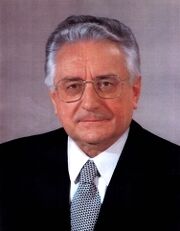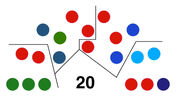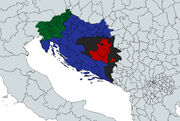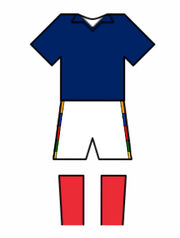
|
This is a featured article of the German Heritage Timeline!
Yugoslavia (German Heritage) is a featured article, which means it has been identified as one of the best pages in the entire timeline. Featured articles should be comprehensive and contain varying subjects pertaining to the subject. FAs are decided by DukeDevon
|
| Federation of YugoslaviaTimeline: German Heritage | ||||||
|---|---|---|---|---|---|---|
|
||||||
| Anthem: “Hey, Slavs” |
||||||
| Capital | Zagreb | |||||
| Largest city | Zagreb | |||||
| Official languages | Serbian Croatian Slovene |
|||||
| Regional languages | German, Hungarian and Italian | |||||
| Religion | Catholics Muslims Orthodox Christians |
|||||
| Demonym | Yugoslav[1] | |||||
| Government | Federal parliamentary Constitutional Republic | |||||
| - | Presidential Council | Šefik Džaferović (Bosniak) Mladen Ivanić (Serb) |
||||
| - | Prime Minister | Kolinda Grabar-Kitarović | ||||
| Legislature | National Parliament
|
|||||
| Establishment | ||||||
| - | Independence Declared from Austria | 7 June, 1932 | ||||
| - | Current Constitution | 1 January 1991 | ||||
| Population | ||||||
| - | August 2018 estimate | 9.5 million | ||||
| Currency | dinar (YUM) |
|||||
| Time zone | CET | |||||
| Date formats | dd.mm.yyyy | |||||
| Drives on the | right | |||||
| Internet TLD | .yu | |||||
Yugoslavia, officially known as the Federation of Yugoslavia (Serbo-Croatian: Federacija Jugoslavije; Slovene: Zveza Jugoslavije), is a Federal State located in South-Eastern Europe.
Yugoslavia sits on the Adriatic Sea and shares land borders with the Venetian Republic, Austria and Hungary to the north, Serbia to the East and south.
After the United States of Greater Austria collapsed in the midst of the Great Depression, the South-Slavic states of Carniola, Croatia and Bosnia united together to form the pan-Slavic State of Slovenes, Croats & Serbs. It was colloquially known as Yugoslavia or Jugoslavia, which evolved to become the official name in the 1950s. Initially, Yugoslavia was a centralised confederation based around the Croatian Republic, the most influential of the republics. After student protects and public demonstrations in 1989-1990, Yugoslavia became a decentralised federation with a more equal regional system, Bosniak representation, and a quadripartite presidency.
Today, Yugoslavia has a stable economy dominated by service and industrial sectors and agriculture. Tourism is a significant source of revenue, with Yugoslavia ranked among the top 20 most popular tourist destinations in the world. The state controls a part of the economy, with substantial government expenditure. Yugoslavia is currently a member of the Pan-European Community and the League of United Nations.
Etymology
The concept of Yugoslavia, as a single state for all South Slavic peoples, emerged in the late 17th century and gained prominence through the Illyrian Movement of the 19th century. The name was created by the combination of the Slavic words "jug" (south) and "slaveni" (Slavs) - Jugoslavia, or Yugoslavia. From 1932 to 1952, it was officially known as the State of Slovenes, Croats and Serbs, which was often abbreviated to SHS. From its inception however, it was primarily known as Yugoslavia. After a referendum in 1951, the nation changed its name to the Federal Republic of Yugoslavia, before finally changing it in 1991 to the current Federation of Yugoslavia.
History
Foundation (1932-19??)
After the Austro-Hungarian state started to collapse in 1932, leaders of the Southern Slavic states started to plan their futures. Anton Korošec, leader of Carniola, Svetozar Pribićević of the Serb Community and Ante Pavelić of Croatia made plans for a pan-Slavic Yugoslav state in the post-collapse balance. The newly founded state was from the beginning dominated by the Croats and Slovenes of the union, causing a measure of enmity between the Yugoslav state and Bosniaks and Serbs.
...German support for the Ustase in an attempt to include Yugoslavia into the Berlin Pact ironically pushed Yugoslavia further away from the imperial sphere-of-influence. However, anti-Serb sentiment also isolated it from NATO, which supported an Yugoslav unification with Serbia. In 1965, under the direction of Vladimir Košak of the HSS joined the European Economic Union, which led to an economic boom in the late ‘60s to mid ‘70s. Yugoslavia became a prime holiday destination, primarily with Germans, Poles and Hungarians. Košak’s foreign policy advocated economic links with both sides (in order to make Yugoslavia prosper) while not committing to any political or military organisations. While benefiting Yugoslavia - the quality of living grew substantially - it also isolated it politically, which meant that in the event of war, Yugoslavia could potentially receive attacks from either side. These factors led Yugoslavia to join with other similarly situated nations to create the foundations of the non-aligned movement.
Tuđman Presidency & Green Revolution (1984-1990)

Franko Tuđman, the last unitary President of Yugoslavia (1984-1990). Under Tuđman‘s tenure, corruption and centralisation increased while the economy declined, leading to a wave of reformist protests in 1989/90, which resulted in his resignation.
Under the presidency of Franjo Tuđman (1984-1990), the economy stagnated and corruption increased, leading to dissatisfaction with the ruling political system in Yugoslavia. Tuđman‘s government, led by the Democratic Party (DSS), embarked on a mass program of privatisation and economic liberalism, which received criticism by Yugoslav economists who characterized it as crony capitalism and as too favourable towards Croatia, at the expense of the other republics. The ruling party was particularly criticised for transferring enterprises to a group of privileged owners connected to the party, and the Yugoslav president Franjo Tuđman was himself also a target of critics and allegations of nepotism and the likelihood that he personally profited. Under Tuđman, the Democratic Party shifted from general liberal conservatism to national conservatism, as well as a strong emphasis on Croatian Nationalism, which further alienated the non-Croatian populace.
Inspired by the Revolutions of 1989/90, Bosniak nationalists surrounding Alija Izetbegović started a wave of protests against the Yugoslav government in Summer 1990. The protesters demanded a number of objectives, namely, the creation of a Bosniak Republic, a true parliamentary system, and an end to the widespread corruption and nepotism. What originated as an exclusively-Bosnian protest soon emerged as a mass, nationwide series of protests against the political system.
The first quadpartitite presidency emerged in 1991, and consisted of the Bosniak Alija Izetbegović, Croatian Zlatko Tomčić, Serbian Biljana Plavšić and Slovene Milan Kučan.
- Vladimkr Kosak (1962-1971)
- Savka Dabčević-Kučar (1971-1984; SD)
- Branko Mikulić (1984-1990)
Economy
Politics

Composition of the 20-member Assembly of Republics. From the bottom left clockwise, the seats are: Bosniak, Croat, Slovene And Serb.

Composition of the 427-member National Assembly of Deputies:
NDS - 178
SD - 152
NLS - 38
KD - 14
AU - 13
JNS - 8
SDA - 8
SRB - 7
SSJ - 6
Independents - 5
The National Parliament is divided into a upper house of 20 members (the Assembly of Republics) and a lower house of 427 members (the Assembly of Deputies). Members of the Assembly of Republics are nominated by the Regional Assemblies of their respective republics. There are five members from each of the four republics. The Deputies are democratically voted into four year terms by national general elections.
Political Parties
- National Democratic Party of Yugoslavia (NDS) is a centre-right party that is led by Kolinda Grabar-Kitarović. The NDS currently holds 178 seats in the National Assembly of Deputies, the most of any party. In the Assembly of Republics, it holds 2 Croatian seats and 1 Serbian seat. The NDS also is part of the ruling coalition, along with the National Liberal Party and the Christian Democrats. The NDS was founded in 1992 as part of the New Democratic movements that formed after the federalisation and inherited a large part of the Croatian Peasant Party’s membership.
- Social Democrats (SD). The SD holds 152 seats in the Assembly of Deputies, and 2 Bosniak seats, two Croat seats, three Slovene seats and 2 Serbian seats.
- National Liberal Party (NLS)
- Christian Democrats (KD)
- Agrarian Union (AU)
- Yugoslav Nationalist Party (JNS) is a right-wing/far-right conservative, populist party that is led by Bruna Esih. The party, which supports de-federalisation and Yugoslav nationalism, mostly finds its support base among young men in Croatia and Slovenia. JNS has seen rapid growth in recent years, with many speculating that it will become a dominant force in politics. In the 2018 General Election, JNS gained 6 seats, pushing it to a total of 8 seats.
- Party of Democratic Action (SDA) is a centre-right Conservative party that represents Bosniak interests in Yugoslavia. It currently holds 8 seats in the Assembly of Deputies and 3 of the five Bosniak seats in the Assembly of the Republics.
- Serb Party (SRB)
- Socialist Party of Yugoslavia (SSJ)
Federal Divisions

Map of the Yugoslav Republics
Slovenia
Croatia
Bosniak Rep.
Srpska
Yugoslavia is divided into four republics, which are autonomous in all affairs apart including broadcasting policy, civil service, common markets, constitution, electricity, coal, oil, gas, defence and national security, drug policy, employment and foreign policy and relations with Europe. Each Republic has a unicameral Republic Assembly, which is elected in four-year terms. The four republics are:
Croatia: Croatia is the largest of the republics, and has its capital at Split. Though formerly in Zagreb, the capital was moved in 1990 as part of Yugoslavia’s federalisation process. It is currently governed by the centre-right Croatian Democratic Union with Gordan Jandroković as its minister-president.
Slovenia: Slovenia sits at the far-north of the country and has its capital at Ljubljana. Slovenia is currently governed by Marjan Šarec and his populist List of Marjan Šarec party. Slovenian politics have historically been dominated by the conservative Slovene People's Party and left-wing Social Democrats.
 Serb Republic (Srpska): Srpska is located in the south-east and has its regional capital at Banja Luka. Serbia is governed by Željka Cvijanović and the left-wing Alliance of Independent Social Democrats. Srpska is one of the poorest regions of Yugoslavia, and decades of local fighting between the Bosniak and Serb inhabitants have left their mark on Serbian society.
Serb Republic (Srpska): Srpska is located in the south-east and has its regional capital at Banja Luka. Serbia is governed by Željka Cvijanović and the left-wing Alliance of Independent Social Democrats. Srpska is one of the poorest regions of Yugoslavia, and decades of local fighting between the Bosniak and Serb inhabitants have left their mark on Serbian society.
Bosniak Republic (Bosnia): Bosnia is located in east of the country, and is surrounded by the Croatian Republic to the West, and Srpska to the East. Bosnia’s capital is the city of Sarajevo. While no party can rule by a majority, Bosnia is led by Fadil Novalić and the Party of Democratic Action. Bosnia is the newest of the republics, having previously been governed as part of Croatia. Bosniak protests in 1989-90 led to the foundation of the republic in 1990-91.
Presidential Council
The Presidential Council is a four-member body that collectively serves as the head of state. The Chairman of the Council is the preceding member, and rotates among the members every 1st of January. The Council is made up of the four ethnic groups of Yugoslavia, the Slovenes, Croats, Serbs and Bosniaks. Since 1991, the chairmanship has rotated Bosniak, Serb, Croat and Slovene. The current council is comprised of:
| Member | Took Office | Representing | ||
|---|---|---|---|---|

|
Andrej Plenković Croatian Democratic Union (1970-) |
January 1, 2016 | Croats | |

|
Chairman Šefik Džaferović Party of Democratic Action (1957-) |
January 1, 2016 | Bosniaks | |

|
Mladen Ivanić Party of Democratic Progress (1958-) |
January 1, 2012 | Serbs | |

|
Borut Pahor Social Democrats (1963-) |
January 1, 2012 | Slovenes | |
Culture
Sports

Yugoslav Team Kit
Football is the most popular sport is Yugoslavia. The Yugoslav National Football Team is one of the best in Europe and is even known as the “Brazilians of Europe”. The Kit (Pictured Right) is the national colours of dark blue, white and red. The shorts have bands of Orange, Blue, Red, Green and Yellow on the side, which symbolises the various ethnic groups.
- Orange - Croats
- Blue - Serbs
- Red - Slovenes
- Green - Bosniaks
- Yellow - Other minorities
The Yugoslav National Tournament takes place every year since 2006 between the four teams of the republics. The current champion is Croatia, who have won a total of 5 championships, with the Serbian team following with a notable 4 victories. Basketball is also popular with Yugoslav youths, and also has a strong national team.
| ||||||||||||||||||||
- ↑ Or, alternately by a person’s state nationality (e.g: Serb, Croatian, etc)



